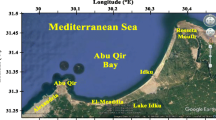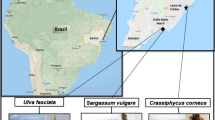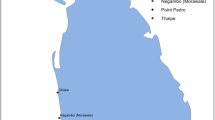Abstract
Biochemical composition and antioxidant activity were assessed in seven seaweeds from Madeira Archipelago, namely, the chlorophyte (Ulva lactuca), the rhodophytes (Asparagopsis taxiformis, Chondrus crispus, Galaxaura rugosa, Grateloupia lanceola and Nemalion elminthoides), and the phaeophyte (Zonaria tournefortii). Seaweed mineral content varied from 16.60 to 84.16 g (100 g)-1 dry weight (dw). Organic matter, composed by fiber and matrix polysaccharides (8.33 to 54.04 g (100 g)-1 dw), starch (1.95 to 25.41 g (100 g)-1 dw), protein (2.80 to 17.55 g (100 g)-1 dw), and fat (1.46 to 12.04 g (100 g)-1 dw), was also determined. Asparagopsis taxiformis was found to have substantial quantities of protein, fat, fiber, and matricial polysaccharides, compared to the other analyzed seaweeds. Analysis of antioxidant components included the measurement of chlorophyll a (28.81 to 244.3 g (100 g)-1 dw), total carotenoids (0 to 297.8 g (100 g)-1 dw), total phenolic compounds (0 to 2154 mg GAE (100 g)-1 dw), and total flavonols (7.27 to 604.8 mg QE (100 g)-1 dw). Zonaria tournefortii was found to possess the highest contents of chlorophyll a, total carotenoids, total phenolic content (TPC), and antioxidant activity, determined through ferric reduction antioxidant potential (FRAP), ferrous ion chelating (FIC), free radical-scavenging assay (FRSA), and β-carotene bleaching (β-CB). Statistical analysis showed 38 significant correlations between various biochemical and antioxidant parameters or activity and determined that fat content showed the highest number of correlations. Overall, this study gives a better understanding of Madeira autochthonous seaweeds in their potential of being introduced as a raw material for nutrient supplementation in various food products or to produce functional foods using seaweed natural properties.

Similar content being viewed by others
References
Abd El-Baky HH, El Baz FK, El-Baroty GS (2008) Evaluation of marine alga Ulva lactuca L. as a source of natural preservative ingredient. Electron J Environ Agric Food Chem 7:3353–3367
Ale MT, Mikkelsen JD, Meyer AS (2011) Differential growth response of Ulva lactuca to ammonium and nitrate assimilation. J Appl Phycol 23:345–351
AOAC (2000) Official methods of analysis. AOAC International, Gaithersburg
AOAC (2005) Official methods of analysis. AOAC International, Gaithersburg
Aruoma OI (1999) Antioxidant actions of plant foods: use of oxidative DNA damage as a tool for studying antioxidant efficacy. Free Radic Res 30:419–427
Athukorala Y, Lee K-W, Song C, Ahn C-B, Shin T-S, Cha Y-J, Shahidi F, Jeon Y-J (2003) Potential antioxidant activity of marine red alga Grateloupia filicina extracts. J Food Lipids 10:251–265
Bligh EG, Dyer WJ (1959) A rapid method of total lipid extraction and purification. Can J Biochem Physiol 37:911–917
Burreson BJ, Moore RE, Roller PP (1976) Volatile halogen compounds in the alga Asparagopsis taxiformis (Rhodophyta). J Agric Food Chem 24:856–861
Castelar B, Reis RP, dos Santos Calheiros AC (2014) Ulva lactuca and U. flexuosa (Chlorophyta, Ulvophyceae) cultivation in Brazilian tropical waters: recruitment, growth, and ulvan yield. J Appl Phycol 26:1989–1999
Chan EWC, Lim YY, Chew YL (2007) Antioxidant activity of Camellia sinensis leaves and tea from a lowland plantation in Malaysia. Food Chem 102:1214–1222
Chandraprabha M, Seenivasan R, Indu H, Geetha S (2012) Biochemical and nanotechnological studies in selected seaweeds of Chennai coast. J Appl Pharm Sci 2:100–107
Chew YL, Lim YY, Omar M, Khoo KS (2008) Antioxidant activity of three edible seaweeds from two areas in Southeast Asia. LWT - Food Sci Technol 41:1067–1072
Chkhikvishvili ID, Ramazanov ZM (2000) Phenolic substances of brown algae and their antioxidant activity. Appl Biochem Microbiol 36:289–291
Cox S, Abu-Ghannam N, Gupta S (2010) An assessment of the antioxidant and antimicrobial activity of six species of edible Irish seaweeds. Int Food Res J 17:205–220
Dawczynski C, Schubert R, Jahreis G (2007) Amino acids, fatty acids, and dietary fibre in edible seaweed products. Food Chem 103:891–899
Dawidowicz AL, Olszowy M (2010) Influence of some experimental variables and matrix components in the determination of antioxidant properties by β-carotene bleaching assay: experiments with BHT used as standard antioxidant. Eur Food Res Technol 231:835–840
Decker EA, Welch B (1990) Role of ferritin as a lipid oxidation catalyst in muscle food? J Agric Food Chem 38:674–677
Denis C, Morançais M, Li M et al (2010) Study of the chemical composition of edible red macroalgae Grateloupia turuturu from Brittany (France). Food Chem 119:913–917
Diniz GS, Barbarino E, Oiano-Neto J, Pacheco S, Lourenço S (2011) Gross chemical profile and calculation of nitrogen-to-protein conversion factors for five tropical seaweeds. Am J Plant Sci 2:287–296
Dreher ML (1987) Handbook of dietary fiber. An applied approach. Marcel Dekker Inc., New York
Duan XJ, Zhang WW, Li XM, Wang BG (2006) Evaluation of antioxidant property of extract and fractions obtained from a red alga, Polysiphonia urceolata. Food Chem 95:37–43
El-Baroty GS, Moussa MY, Shallan MA, Ali MA, Sabh AZ, Shalaby EA (2007) Contribution to the aroma, biological activities, minerals, protein, pigments and lipid contents of the red alga: Asparagopsis taxiformis (Delile) Trevisan. J Appl Sci Res 3:1825–1834
Elmegeed DFA, Ghareeb D, El-saadani M (2014) Phytochemical constituents and bioscreening activities of green algae (Ulva lactuca). Int J Agric Policy Res 2:373–378
Farvin SKH, Jacobsen C (2013) Phenolic compounds and antioxidant activities of selected species of seaweeds from Danish coast. Food Chem 138:1670–1681
Folch J, Lees M, Stanley GHS (1957) A simple method for the isolation and purification of total lipids from animal tissues. J Biol Chem 226:497–509
Galland-Irmouli AV, Fleurence J, Lamghari R, Luçon M, Rouxel C, Barbaroux O, Bronowicki J-P, Villaume C, Guéant J-L (1999) Nutritional value of proteins from edible seaweed Palmaria palmata (dulse). J Nutr Biochem 10:353–359
Hardouin K, Burlot AS, Umami A, Tanniou A, Stiger-Pouvreau V, Widowati I, Bedoux G, Bourgougnon N (2013) Biochemical and antiviral activities of enzymatic hydrolysates from different invasive French seaweeds. J Appl Phycol 26:1029–1042
Hodge J, Hofreiter B (1962) Analysis and preparation of sugars. In: Whistler BM (ed) Methods in carbohydrate chemistry. Academic Press, New York, pp 356–378
Holdt SL, Kraan S (2011) Bioactive compounds in seaweed: functional food applications and legislation. J Appl Phycol 23:543–597
Hoshiyama Y, Sekine T, Sasaba T (1993) A case-control study of colorectal cancer and its relation to diet, cigarettes, and alcohol consumption in Saitama prefecture, Japan. Tohoku J Exp Med 171:153–165
Ismail A, Tan S (2002) Antioxidant activity of selected commercial seaweeds. Malays J Nutr 8:167–177
Jiménez-Escrig A, Sánchez-Muniz FJ (2000) Dietary fibre from edible seaweeds: chemical structure, physicochemical properties and effects on cholesterol metabolism. Nutr Res 20:585–598
Jiménez-Escrig A, Gómez-Ordóñez E, Tenorio MD, Rupérez P (2013) Antioxidant and prebiotic effects of dietary fiber co-travelers from sugar kombu in healthy rats. J Appl Phycol 25:503–512
Kendel M, Wielgosz-Collin G, Bertrand S, Roussakis C, Bourgougnon N, Bedoux G (2015) Lipid composition, fatty acids and sterols in the seaweeds Ulva armoricana, and Solieria chordalis from Brittany (France): an analysis from nutritional, chemotaxonomic, and antiproliferative activity perspectives. Mar Drugs 13:5606–5628
Kılınç B, Cirik S, Turan G, Tekogul H, Koru E (2013) Seaweeds for food and industrial applications. In: Muzzalupo I (ed) Food industry. Rijeka, InTech, pp 735–748
Kristinsson HG (ed) (2014) Antioxidants and functional components in aquatic foods. Wiley-Blackwell, Oxford
Kumar JIN, Kumar RN, Bora A, Kaur Amb M, Chakraborthy S (2010) An evaluation of the pigment composition of eighteen marine macroalgae collected from Okha Coast, Gulf of Kutch, India. Our Nature 7:48–55
Kumar M, Gupta V, Kumari P, Reddy CRK, Jha B (2011) Assessment of nutrient composition and antioxidant potential of Caulerpaceae seaweeds. J Food Compos Anal 24:270–278
Kumaran A, Karunakaran JR (2006) Antioxidant and free radical scavenging activity of an aqueous extract of Coleus aromaticus. Food Chem 97:109–114
Lanfer-Marquez UM, Barros RMC, Sinnecker P (2005) Antioxidant activity of chlorophylls and their derivatives. Food Res Int 38:885–891
Li Y, Guo C, Yang J, Wei J, Xu J, Cheng S (2006) Evaluation of antioxidant properties of pomegranate peel extract in comparison with pomegranate pulp extract. Food Chem 96:254–260
Lourenço SO, Barbarino E, De-Paula JC, Pereira L, Marquez U (2002) Amino acid composition, protein content and calculation of nitrogen-to-protein conversion factors for 19 tropical seaweeds. Phycol Res 50:233–241
Mageswaran R, Sivasubramaniam S (1984) Mineral and protein contents of some marine algae from the coastal areas of northern Sri Lanka. J Nam Sci Coun SriLanka 12:179–189
Mahadevan K (2015) Seaweeds: a sustainable food source. In: Brijesh K, Tiwari DT (eds) Seaweed sustainability. Academic Press, NY pp 347–364
Manivannan K, Thirumaran G, Devi GK, Hemalatha A, Anantharaman P (2008) Biochemical composition of seaweeds from Mandapam coastal regions along southeast coast of India. Am J Bot 1:32–37
Matanjun P, Mohamed S, Mustapha NM, Muhammad K, Ming C (2008) Antioxidant activities and phenolics content of eight species of seaweeds from north Borneo. J Appl Phycol 20:367–373
Meenakshi S, Gnanambigai DM, Tamil S, Arumugam M, Balassubramanian T (2009) Total flavanoid and in vitro antioxidant activity of two seaweeds of Rameshwaram coast. Glob J Pharmacol 3:59–62
Meland M, Rebours C (2012) Seaweed industry in Europe. Bioforsk – Norwegian Institute for Agricultural and Environmental Research, Norway. http://www.netalgae.eu. Accessed 20 Feb 2016
Mishra VK, Temelli F, Ooraikul B, Shacklock PF, Craigie JS (1993) Lipids of the red alga, Palmaria palmata. Bot Mar 36:2011–2013
Miyashita K (2014) Marine antioxidants: polyphenols and carotenoids from algae. In: Kristinsson HG (ed) Antioxidants and functional components in aquatic foods. Wiley-Blackwell, Oxford, pp 233–249
Mozaffarian D (2005) Does alpha-linolenic acid intake reduce the risk of coronary heart disease? A review of the evidence. Altern Ther Health Med 11:24–31
Munier M, Dumay J, Morançais M, Jaouen P, Fleurence J (2013) Variation in the biochemical composition of the edible seaweed Grateloupia turuturu Yamada harvested from two sampling sites on the Brittany coast (France): the influence of storage method on the extraction of the seaweed pigment R-phycoerythrin. J Chem 2013:568548
Navy P (2015) Globalization and the sea. The maritime dimension of Portugal, Lisbon
Nielsen MM, Bruhn A, Rasmussen MB, Olesen B, Larsen M, Moller H (2012) Cultivation of Ulva lactuca with manure for simultaneous bioremediation and biomass production. J Appl Phycol 24:449–458
Okuzumi J, Takahashi T, Yamane T, Kitao Y, Inagake M, Ohya K, Nishino H, Tanaka Y (1993) Inhibitory effects of fucoxanthin, a natural carotenoid, on N-ethyl-N′-nitro-N-nitrosoguanidine-induced mouse duodenal carcinogenesis. Cancer Lett 68:159–168
Ortiz J, Romero N, Robert P, Araya J, Lopez-Hernández J, Bozzo C, Navarrete E, Osorio A, Rios A (2006) Dietary fiber, amino acid, fatty acid and tocopherol contents of the edible seaweeds Ulva lactuca and Durvillaea antarctica. Food Chem 99:98–104
Oyaizu M (1986) Studies on products of browning reaction. Antioxidative activities of products of browning reaction prepared from glucosamine. Jap J Nutr Diet 44:307–315
Pereira JC (2005) Avaliação do potencial energético solar. ERAMAC - Maximização da penetração das energias renováveis e utilização racional da energia nas ilhas da Macaronésia. AREAM and IDMEC final report, Funchal
Pereira L (2015) Introduction to marine biotechnology. In: Kim S-K, Venkatesan J (eds) Springer handbook of marine biotechnology. Springer, Berlin, pp 65–178
Prior RL, Wu X, Schaich K (2005) Standardized methods for the determination of antioxidant capacity and phenolics in foods and dietary supplements. J Agric Food Chem 53:4290–4302
Quej V, Almorox J, Ibrakhimov M, Saito L (2017) Estimating daily global solar radiation by day of the year in six cities located in the Yucatán peninsula, Mexico. J Clean Prod 141:75–82
Ragan M, Glombitza K (1986) Phlorotannins, brown algal polyphenols. Prog Phycol Res 4:130–132
Ragonese C, Tedone L, Beccaria M, Torre G, Cichello F, Cacciola F, Dugo P, Mondello L (2014) Characterisation of lipid fraction of marine macroalgae by means of chromatography techniques coupled to mass spectrometry. Food Chem 145:932–940
Rengasamy KRR, Amoo SO, Aremu AO, Stirk WA, Gruz J, Šubrtová M, Doležal K, Van Staden J (2015) Phenolic profiles, antioxidant capacity, and acetylcholinesterase inhibitory activity of eight south African seaweeds. J Appl Phycol 27:1599–1605
Rosegrant MW, Cline SA (2003) Global food security: challenges and policies. Science 302:1917–1919
Sarojini Y, Lakshminarayana K, Rao PS (2012) Variations in distribution of flavonoids in some seaweed of Visakhapatnam coast of India. Pharma Chem 4:1481–1484
Seo M-J, Choi H-S, Lee O-H, Lee B-Y (2013) Grateloupia lanceolata (Okamura) Kawaguchi, the edible red seaweed, inhibits lipid accumulation and reactive oxygen species production during differentiation in 3T3-L1 cells. Phytother Res 27:655–663
Shuuluka D, Bolton JJ, Anderson RJ (2013) Protein content, amino acid composition and nitrogen-to-protein conversion factors of Ulva rigida and Ulva capensis from natural populations and Ulva lactuca from an aquaculture system, in South Africa. J Appl Phycol 25:677–685
Stern JL, Hagerman AE, Steinberg PD, Winter F, Estes J (1996) A new assay for quantifying brown algal phlorotannins and comparisons to previous methods. J Chem Ecol 22:1273–1293
Takaichi S (2013) Distributions, biosyntheses and functions of carotenoids in algae. Agro Food Ind Hi Tech 24:55–58
Tanniou A, Vandanjon L, Incera M, Leon E, Husa V, Le Grand J, Nicolas J, Poupart N, Kervarec N, Engelen A, Walsh R, Guerard F, Bourgougnon N, Stiger-Pouvreau V (2014) Assessment of the spatial variability of phenolic contents and associated bioactivities in the invasive alga Sargassum muticum sampled along its European range from Norway to Portugal. J Appl Phycol 26:1215–1230
Toth G, Pavia H (2000) Lack of phlorotannin induction in the brown seaweed Ascophillum nodosum in response to increased copper concentrations. Mar Ecol Prog Ser 192:119–126
Trumbo P, Schlicker S, Yates AA, Poos M (2002) Dietary reference intakes for energy, carbohydrate, fiber, fat, fatty acids, cholesterol, protein and amino acids. J Am Diet Assoc 102:1621–1630
Van Hal M (2000) Quality of sweet potato flour during processing and storage. Food Rev Int 16:1–37
Velioglu YS, Mazza G, Gao L, Oomah BD (1998) Antioxidant activity and total phenolics in selected fruits, vegetables, and grain products. J Agric Food Chem 46:4113–4117
von Elbe J, Schwartz S (1996) Colorants. In: Dekker M (ed) Food chemistry. CRC Press, New York, pp 651–722
Wang T, Jónsdóttir R, Ólafsdóttir G (2009) Total phenolic compounds, radical scavenging and metal chelation of extracts from Icelandic seaweeds. Food Chem 116:240–248
Wellburn AR (1994) The spectral determination of chlorophylls a and b, as well as total carotenoids, using various solvents with spectrophotometers of different resolution. J Plant Physiol 144:307–313
Yaich H, Garna H, Besbes S, Paquot M, Blecker C, Attia H (2011) Chemical composition and functional properties of Ulva lactuca seaweed collected in Tunisia. Food Chem 128:895–901
Yen G-C, Chen H-Y (1995) Antioxidant activity of various tea extracts in relation to their antimutagenicity. J Agric Food Chem 43:27–32
Yoshie-Stark Y, Hsieh Y, Suzuki T (2003) Distribution of flavonoids and related compounds from seaweeds in Japan. J Tokyo Univ Fish 89:1–6
Yuan YV, Bone DE, Carrington MF (2005) Antioxidant activity of dulse (Palmaria palmata) extract evaluated in vitro. Food Chem 91:485–494
Zertuche-González J, García-Lepe G, Pacheco-Ruiz I, Chee A, Gendrop V, Guzmán JM (2001) Open water Chondrus crispus Stackhouse cultivation. J Appl Phycol 13:247–251
Zhang WW, Duan XJ, Huang HL, Zhang Y, Wang B-G (2007) Evaluation of 28 marine algae from the Qingdao coast for antioxidative capacity and determination of antioxidant efficiency and total phenolic content of fractions and subfractions derived from Symphyocladia latiuscula (Rhodomelaceae). J Appl Phycol 19:97–108
Zubia M, Robledo D, Freile-Pelegrin Y (2007) Antioxidant activities in tropical marine macroalgae from the Yucatan peninsula, Mexico. J Appl Phycol 19:449–458
Author information
Authors and Affiliations
Corresponding author
Rights and permissions
About this article
Cite this article
Nunes, N., Ferraz, S., Valente, S. et al. Biochemical composition, nutritional value, and antioxidant properties of seven seaweed species from the Madeira Archipelago. J Appl Phycol 29, 2427–2437 (2017). https://doi.org/10.1007/s10811-017-1074-x
Received:
Revised:
Accepted:
Published:
Issue Date:
DOI: https://doi.org/10.1007/s10811-017-1074-x




